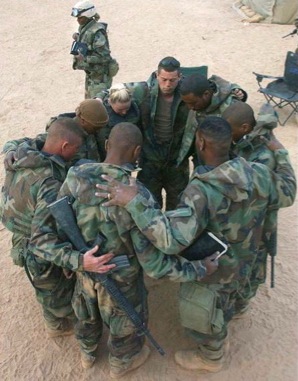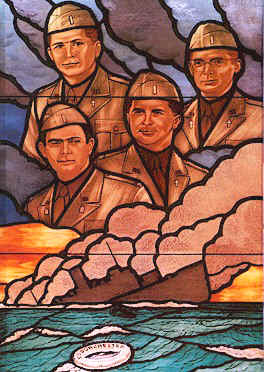 Last Sunday's 8,000-plus-word takeout in The Washington Post Magazine on military chaplains is a tremendous example of why long-form journalism is so helpful in dealing with complex religious issues. The magazine's editors gave Kristin Henderson, the wife of a Navy chaplain and author of While They're at War: The True Story of American Families on the Homefront, the space needed to tell the story of why chaplains are a necessary part of the U.S. military operations and some of the immense challenges they face:
Last Sunday's 8,000-plus-word takeout in The Washington Post Magazine on military chaplains is a tremendous example of why long-form journalism is so helpful in dealing with complex religious issues. The magazine's editors gave Kristin Henderson, the wife of a Navy chaplain and author of While They're at War: The True Story of American Families on the Homefront, the space needed to tell the story of why chaplains are a necessary part of the U.S. military operations and some of the immense challenges they face:
The soldier nicknamed Razz is standing on the platform between the two back seats, half in, half out of a hole in the roof, manning the .50 caliber machine gun mounted in the turret. He scrunches down as the overpass closes in. His butt settles into a sling hanging next to the head of a fourth soldier in the backseat, a man who's not part of the crew, who seems to be doing nothing. He's Chaplain John Smith.
Smith, 32, has been preaching since he was 16, has a bachelor's degree in psychology and a master's in divinity. But he looks like a kid, walks like a kid, high-speed and bouncy-toed. He first arrived in Iraq four months ago, a brand new captain fresh out of an Assemblies of God seminary and Army chaplains school. Back on the forward operating base, or FOB, Smith leads two different services every Sunday, one an intellectual hymn to traditional [P]rotestantism, the other a two-hour, standing-room-only Pentecostal throw-down. Together, the two services reflect Smith himself, brainy and charismatic. Six to seven soldiers a day come into [Smith's] office for counseling; more pull him aside as he passes through their workspaces on his daily visitation rounds.
This Humvee is one of his soldiers' workspaces.
 The military chaplaincy has become ever more controversial these days, and a growing chorus is calling for the practice to be re-examined. The issue also gets more complicated in Muslim countries and for Jewish chaplains. This type of journalism has an impact in government politics and policies. Not only do policymakers read such articles, but they also hear about them from their wives, children, friends and fellow church members. This article excels not only in its descriptive color, but also in its deep understanding of the issue:
The military chaplaincy has become ever more controversial these days, and a growing chorus is calling for the practice to be re-examined. The issue also gets more complicated in Muslim countries and for Jewish chaplains. This type of journalism has an impact in government politics and policies. Not only do policymakers read such articles, but they also hear about them from their wives, children, friends and fellow church members. This article excels not only in its descriptive color, but also in its deep understanding of the issue:
Chaplains can come from any faith group that has established a relationship with the Department of Defense. But statistics from the Defense Manpower Data Center indicate that while Christian fundamentalist and evangelical service members make up less than 20 percent of the military, more than a third of military chaplains come from such denominations. As a result, for every Southern Baptist chaplain, there are only 40 Southern Baptist service members. By comparison, Roman Catholics, who constitute the military's single biggest religious group, make do with one priest for every 800 Catholic service members.
Captain Edward Grimenstein, a Lutheran who has been an Army chaplain for only two years, explains the large number of evangelical chaplains in his class this way: "It's in their theological doctrine -- very pro-nation, pro-government, pro-country. You don't find that in a lot of mainline Protestant denominations."
Pentagon policy acknowledges that these days Americans practice a wider variety of religions than ever before. Prior to becoming an Army chaplain, a candidate must certify that he or she is "sensitive to religious pluralism and able to provide for the free exercise of religion by all military personnel, their family members, and civilians who work for the Army." Chaplains don't lead worship services outside their own faith group, but they do have to make sure that every other recognized faith group has the supplies and space they need to practice their religion. Officially, proselytizing is forbidden, but recent headlines indicate that commandment isn't always obeyed.
A washingtonpost.com online chat with Henderson is just as interesting -- if not for the answers, then for the questions asked, especially the first one. Clearly Henderson knows her subject and understands the importance of religion. Her article will help people better understand the challenges involved in being a chaplain in the U.S. military.
